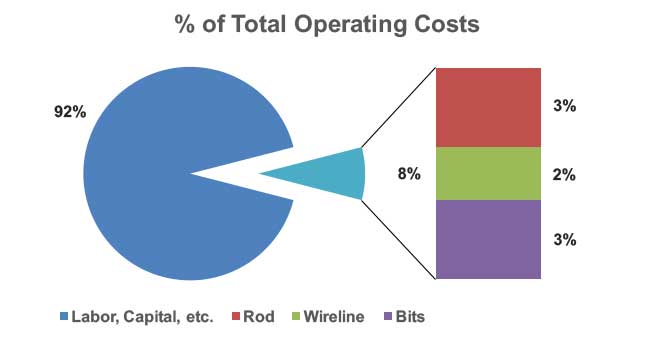EXPLORATION
12 avril 2017
Le coût caché des tiges de forage moins chères
La sagesse conventionnelle nous dit qu'un sou économisé est un sou gagné. Toutefois, s’agissant de l’achat de tiges de forage, le fait de pincer des sous pourrait augmenter vos coûts d’exploitation et mettre votre réputation en péril.
En raison des dépenses considérables liées aux tiges de carottage, il est compréhensible que de nombreux entrepreneurs se concentrent sur le prix d’achat pour tenter de réduire les coûts au minimum. Pour certaines décisions d'achat, cela est parfaitement logique.
Mais, tout comme lors de l'achat d'un nouveau véhicule, il est important de prendre en compte plus que le prix de la vignette. Après tout, le «véritable» coût de ce véhicule flambant neuf dépend du coût au kilomètre - et cela dépend en grande partie des habitudes de conduite, de la consommation de carburant, des besoins en matière de maintenance, des pannes potentielles et de la qualité générale du véhicule.
Voici un résumé du rapport: Le coût caché des tiges de forage moins chères.
Télécharger le rapport complet pour en savoir plus sur la qualité, l'utilisation des meilleures pratiques, les coûts d'exploitation et de propriété.
✕Dans notre industrie, la mesure comparable est le coût au mètre. Et en réalité, la qualité des cannes, l’état des trous et leur utilisation ont beaucoup plus à voir avec le coût par mètre d’une ficelle que le prix d’achat initial.
Voici quelque chose à considérer.
Dans une opération de carottage en diamant typique, les consommables ne représentent que 8 à 10% des coûts d'exploitation d'un entrepreneur. La tige de carottage représente généralement 40% de ce montant, soit environ 3% du coût total.
Supposons donc que vous achetez une tige de carottage coûtant 25% moins cher qu'un produit concurrent. Êtes-vous vraiment sauver quelque chose? Peut être pas.
Tout d'abord, considérons la grande image. Dépenser 25% de moins sur 3% de vos dépenses d'exploitation représente en réalité une économie de moins de 1%. Dans l'ensemble, c'est assez faible par rapport aux coûts d'exploitation totaux.
Étant donné que la manipulation et l'utilisation de tiges de carottage pendant les opérations sur le terrain coûtent beaucoup plus cher que le coût d'achat, il est important de regarder au-delà du coût initial.
Si plusieurs tiges ont la même résistance, la décision ne devrait pas être basée sur le coût initial, mais plutôt sur le coût par mètre le plus bas. Par exemple, une canne 25% plus chère mais 50 fois plus longue a un coût par mètre inférieur - et cela peut représenter une économie considérable.
Au-delà de la solidité et de la durabilité des joints, la manière dont un entrepreneur gère la tige sur le terrain a un impact considérable sur la durée de vie de la tige et sur les chances de chute d'une ficelle, ce qui a une incidence sur la productivité. Le fait de creuser à nouveau un trou ou de manipuler des tiges non collantes prend du temps et peut avoir des conséquences néfastes sur les coûts d'exploitation et sur votre réputation auprès de votre client.
Compte tenu des incertitudes liées aux zones de cisaillement, aux formations de gonflement, aux vides et à d’autres variables, même la technique de forage la plus précise ne peut empêcher totalement les tiges bloquées - une conduite aussi prudente ne peut garantir que vous ne courrez pas un accident dans ce nouveau véhicule. à vous.
Mais avoir la canne la plus solide possible augmente vos chances de pouvoir sortir du trou sans casser les cannes et sans avoir à pêcher ou à les percer. C'est comme une police d'assurance qui vous permettra d'économiser des coûts d'exploitation importants en évitant davantage de temps d'arrêt lorsque de telles situations se produisent.
Donc, si vous tenez vraiment à réduire les coûts et à protéger votre réputation, ne pincez pas un sou. Veillez à utiliser la canne la plus résistante et de la plus haute qualité possible, telle que Boart Longyear RQ ™. Avec un coût par mètre inférieur à celui de toute autre tige du marché, il vous aidera à vous sortir des problèmes et à vous faire économiser de l'argent à long terme.
TÉLÉCHARGER
Téléchargez la présentation complète pour en savoir plus sur la qualité,
utilisation conforme aux meilleures pratiques, coût d’exploitation et de propriété.
TÉLÉCHARGER LE FICHIER PDF
Permission de média: Boart Longyear vous autorise immédiatement à republier cet article. Nous vous demandons de citer Boart Longyear comme source et de fournir un lien le cas échéant.





